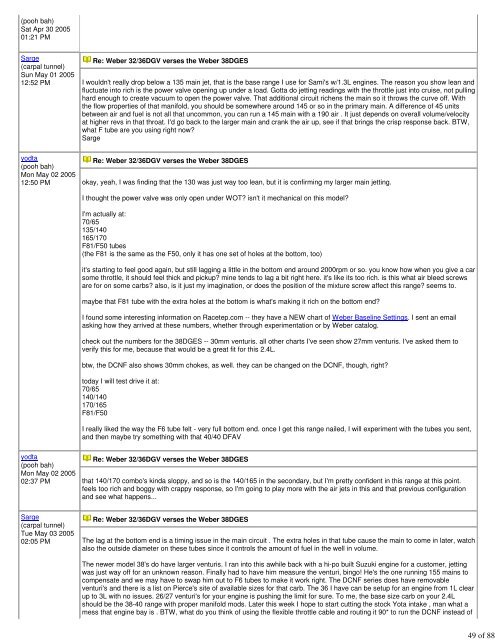Create successful ePaper yourself
Turn your PDF publications into a flip-book with our unique Google optimized e-Paper software.
(pooh bah)<br />
Sat Apr 30 2005<br />
01:21 PM<br />
Sarge<br />
(carpal tunnel)<br />
Sun May 01 2005<br />
12:52 PM<br />
yodta<br />
(pooh bah)<br />
Mon May 02 2005<br />
12:50 PM<br />
yodta<br />
(pooh bah)<br />
Mon May 02 2005<br />
02:37 PM<br />
Sarge<br />
(carpal tunnel)<br />
Tue May 03 2005<br />
02:05 PM<br />
Re: <strong>Weber</strong> <strong>32</strong>/<strong>36DGV</strong> <strong>verses</strong> <strong>the</strong> <strong>Weber</strong> <strong>38DGES</strong><br />
I wouldn't really drop below a 135 main jet, that is <strong>the</strong> base range I use for Sami's w/1.3L engines. The reason you show lean and<br />
fluctuate into rich is <strong>the</strong> power valve opening up under a load. Gotta do jetting readings with <strong>the</strong> throttle just into cruise, not pulling<br />
hard enough to create vacuum to open <strong>the</strong> power valve. That additional circuit richens <strong>the</strong> main so it throws <strong>the</strong> curve off. With<br />
<strong>the</strong> flow properties of that manifold, you should be somewhere around 145 or so in <strong>the</strong> primary main. A difference of 45 units<br />
between air and fuel is not all that uncommon, you can run a 145 main with a 190 air . It just depends on overall volume/velocity<br />
at higher revs in that throat. I'd go back to <strong>the</strong> larger main and crank <strong>the</strong> air up, see if that brings <strong>the</strong> crisp response back. BTW,<br />
what F tube are you using right now?<br />
Sarge<br />
Re: <strong>Weber</strong> <strong>32</strong>/<strong>36DGV</strong> <strong>verses</strong> <strong>the</strong> <strong>Weber</strong> <strong>38DGES</strong><br />
okay, yeah, I was finding that <strong>the</strong> 130 was just way too lean, but it is confirming my larger main jetting.<br />
I thought <strong>the</strong> power valve was only open under WOT? isn't it mechanical on this model?<br />
I'm actually at:<br />
70/65<br />
135/140<br />
165/170<br />
F81/F50 tubes<br />
(<strong>the</strong> F81 is <strong>the</strong> same as <strong>the</strong> F50, only it has one set of holes at <strong>the</strong> bottom, too)<br />
it's starting to feel good again, but still lagging a little in <strong>the</strong> bottom end around 2000rpm or so. you know how when you give a car<br />
some throttle, it should feel thick and pickup? mine tends to lag a bit right here. it's like its too rich. is this what air bleed screws<br />
are for on some carbs? also, is it just my imagination, or does <strong>the</strong> position of <strong>the</strong> mixture screw affect this range? seems to.<br />
maybe that F81 tube with <strong>the</strong> extra holes at <strong>the</strong> bottom is what's making it rich on <strong>the</strong> bottom end?<br />
I found some interesting information on Racetep.com -- <strong>the</strong>y have a NEW chart of <strong>Weber</strong> Baseline Settings. I sent an email<br />
asking how <strong>the</strong>y arrived at <strong>the</strong>se numbers, whe<strong>the</strong>r through experimentation or by <strong>Weber</strong> catalog.<br />
check out <strong>the</strong> numbers for <strong>the</strong> <strong>38DGES</strong> -- 30mm venturis. all o<strong>the</strong>r charts I've seen show 27mm venturis. I've asked <strong>the</strong>m to<br />
verify this for me, because that would be a great fit for this 2.4L.<br />
btw, <strong>the</strong> DCNF also shows 30mm chokes, as well. <strong>the</strong>y can be changed on <strong>the</strong> DCNF, though, right?<br />
today I will test drive it at:<br />
70/65<br />
140/140<br />
170/165<br />
F81/F50<br />
I really liked <strong>the</strong> way <strong>the</strong> F6 tube felt - very full bottom end. once I get this range nailed, I will experiment with <strong>the</strong> tubes you sent,<br />
and <strong>the</strong>n maybe try something with that 40/40 DFAV<br />
Re: <strong>Weber</strong> <strong>32</strong>/<strong>36DGV</strong> <strong>verses</strong> <strong>the</strong> <strong>Weber</strong> <strong>38DGES</strong><br />
that 140/170 combo's kinda sloppy, and so is <strong>the</strong> 140/165 in <strong>the</strong> secondary, but I'm pretty confident in this range at this point.<br />
feels too rich and boggy with crappy response, so I'm going to play more with <strong>the</strong> air jets in this and that previous configuration<br />
and see what happens...<br />
Re: <strong>Weber</strong> <strong>32</strong>/<strong>36DGV</strong> <strong>verses</strong> <strong>the</strong> <strong>Weber</strong> <strong>38DGES</strong><br />
The lag at <strong>the</strong> bottom end is a timing issue in <strong>the</strong> main circuit . The extra holes in that tube cause <strong>the</strong> main to come in later, watch<br />
also <strong>the</strong> outside diameter on <strong>the</strong>se tubes since it controls <strong>the</strong> amount of fuel in <strong>the</strong> well in volume.<br />
The newer model 38's do have larger venturis. I ran into this awhile back with a hi-po built Suzuki engine for a customer, jetting<br />
was just way off for an unknown reason. Finally had to have him measure <strong>the</strong> venturi, bingo! He's <strong>the</strong> one running 155 mains to<br />
compensate and we may have to swap him out to F6 tubes to make it work right. The DCNF series does have removable<br />
venturi's and <strong>the</strong>re is a list on Pierce's site of available sizes for that carb. The 36 I have can be setup for an engine from 1L clear<br />
up to 3L with no issues. 26/27 venturi's for your engine is pushing <strong>the</strong> limit for sure. To me, <strong>the</strong> base size carb on your 2.4L<br />
should be <strong>the</strong> 38-40 range with proper manifold mods. Later this week I hope to start cutting <strong>the</strong> stock Yota intake , man what a<br />
mess that engine bay is . BTW, what do you think of using <strong>the</strong> flexible throttle cable and routing it 90* to run <strong>the</strong> DCNF instead of<br />
49 of 88


